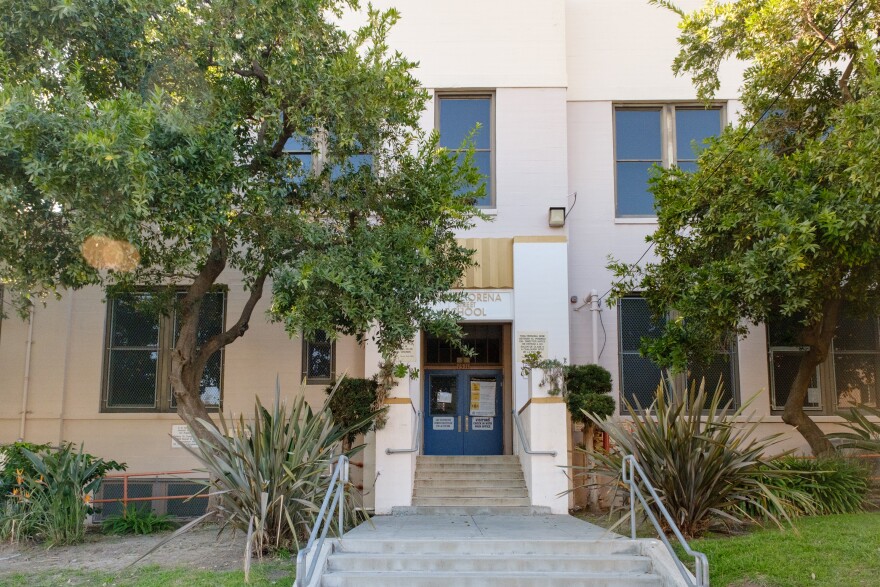This all started as a side project.
Since I began reporting on Los Angeles Unified School District in 2016, I’ve wanted to know how parents’ donations to their schools affected funding equity. Parents, principals and school officials talked about fundraising as if it were an X-factor — an unknowable, mysterious number that played a crucial role in school budgets.
However, most of the data I could find seemed incomplete. Not all the money a PTA or booster club spends also appears as a line item on a district budget. School district documents only told part of the story.
Then I found a June 2019 blog post by longtime LAUSD watcher Sara Roos that helped turn this side project into the package of stories we’re publishing now. In her post, Roos suggested another way to find the answers I sought — the source of data that underlies this project: tax records.
Finding The Fundraising Organizations
Parent fundraising groups in LAUSD must register as tax-exempt, not-for-profit organizations. That means PTAs and booster clubs must publicly disclose information about themselves each year — including, if they raise enough money, information about their annual revenues and assets.
Organizations with more than $50,000 in annual gross receipts file an Internal Revenue Service Form 990 each year. Organizations with less revenues don’t report as much information to the IRS, but do often disclose basic financial data in annual filings with California’s Registry of Charitable Trusts.
I began in November 2019 by building a list of every parent fundraising organization I could find. I found my first results by sifting through Guidestar’s database of tax records, comparing addresses and names with a list of LAUSD schools. Eventually, I used IRS data files, the state registry and a document provided by LAUSD via public records request to round out a list of 414 independent organizations established to raise funds for schools: PTAs, booster clubs and other parent fundraising organizations (PTOs, PTSAs, foundations, etc.). Among those 414 organizations, 348 reported revenues.
Organizations Included And Excluded
This database excludes data about parent fundraising at independent charter schools. This is a clear limitation of my database — but it’s also the result of limitations in the available data.
Charter schools are themselves non-profit organizations, and parents sometimes donate directly to the school instead of establishing a separate PTA or foundation. When charters do this, the Public Policy Institute of California concluded “it is quite difficult to distinguish voluntary [parent] contributions from other state and federal revenues.” Including partial data on parent fundraising from charter schools could lead to unfair comparisons between schools. Ultimately, PPIC made the same call as I did: to leave independent charters out. (I do include data from affiliated charters.)
I did my best to exclude booster clubs that purely support athletics or a single extracurricular activity, but I inevitably had to make judgment calls in perhaps a dozen borderline cases. If there was evidence in available records that the organization supported academics or student scholarships, I erred on the side of inclusion in the database.
My colleague Melissa DeMund built an (excellent) map and search tool for exploring the database. If your school has a parent fundraising group but our map reports “no PTA data was found,” that may be because your school’s parent fundraising organization reported no revenues or isn’t up-to-date on its paperwork. There are 67 organizations in the database — including at least a dozen that still appear to be active — listed as having $0 in revenue.
Despite all my double- and triple-checking with the help of human sources and computer-assisted data scraping, it’s also possible that I made an error and missed an organization. If you believe my numbers are off for your school, please let me know — here’s my contact information.
Totals, Averages, Counts And Schools
Here’s what you need to know to understand the numbers we include on our map and search tool:
What counts as a “school” on our map?
Many LAUSD campuses include more than one entity that you could plausibly call a “school” — a magnet program or a small-school academy, for example. I couldn’t obtain good demographic and financial data on each of these specific “schools-within-a-school.” I also couldn’t always determine whether a PTA or booster club existed to benefit an entire campus or a specific program.
I sidestep this problem by relying on the California Department of Education’s definition, which considers many of these “schools-within-a-school” as part of one whole. (To get as technical as possible about this: I nested all information within a school’s CDS Code.)
For example, Eagle Rock Elementary and the Eagle Rock Highly Gifted Magnet are rolled into the one “school” listed in the state’s directory — and therefore are rolled into one result in our database: Eagle Rock Elementary.
However, other schools that share the same address or campus sometimes appear in our database as two different "schools" — because that's how the California Department of Education thinks of them. For example, Roosevelt High School and the Roosevelt Senior High Science/Tech/Math Magnet in Boyle Heights each have their own listing on our map.
What years of data do you use?
I collected data from tax years running roughly in line with the five school years between 2015-16 and 2019-20. Because of the timelines involved with filing and disclosing Forms 990, data associated with the 2019-20 school year wasn’t available for roughly one-third of the parent organizations in the database at the time I stopped data entry.
What do you mean by “Average amount parents at this school raised annually”?
The total revenues from all PTAs and booster clubs associated with this school over the five-year period covered by my data collection, divided by the number of years from which data is available (i.e. If there was no revenue data from a given year, that year was not included in the denominator).
What do you mean by “Average amount parents at this school raised annually per student”?
Similar to the last field, the total revenues divided by the total number of students enrolled in each of the years from which revenue data was available (i.e. If there was no revenue data from a given year, the school’s enrollment total from that year was excluded from the denominator).
What do you mean by “Average amount parents in the district raised annually per student”?
Calculated in a comparable manner to the schools field, I added up all revenues from parent organizations at all schools. I then divided that figure by the number of students enrolled at schools in years they reported revenues (i.e. If there was no revenue data from a given year, the school’s enrollment total from that year was excluded from the denominator.)
Why are there rankings?
My editors and I wanted to include a straightforward way for you to quickly and easily compare fundraising totals to other schools. We ranked each school based on the average annual parent fundraising per student as calculated above.
What do you mean by “Percentage of students in this school considered low-income in 2019-20”:
This refers to the percentage of K-12 students at the school who receive free or reduced-price meals — that metric is key to distributing Title I funding.
Where does the revenue data comes from?
I collected information on the total revenues that parent fundraising organizations reported on an IRS Form 990. I also collected revenue information organizations reported on their California Form RRF-1. The state’s official guidance asks organizations to report the same revenues on the state form that they’d report on their Form 990, but in cases where we have two documents from the same year with different totals, the database defaults to the figure reported on the Form 990.
Want To Download Our Data?
We've made it available for download via Datawrapper — and there's more data in the file than we display in the table above.
In addition to the annual parent fundraising revenues, the downloadable file includes a breakdown of schools' student enrollment, including demographic information, from the 2019-20 school year.
The downloadable file also shows how I sorted the schools into the 44 "neighborhoods" on our map. (The "neighborhoods" are based mostly on the boundaries of LAUSD's Communities of Schools.)
-
The Jane and Ron Olson Center for Investigative Reporting helped make this project possible. Ron Olson is an honorary trustee of Southern California Public Radio. The Olsons do not have any editorial input on the stories we cover.








